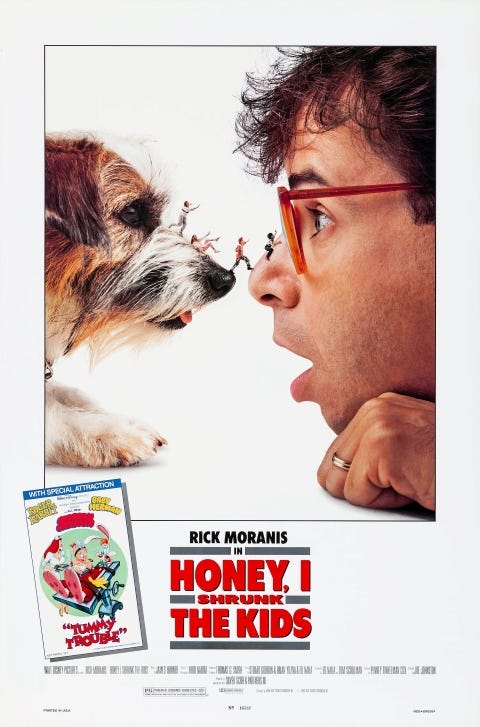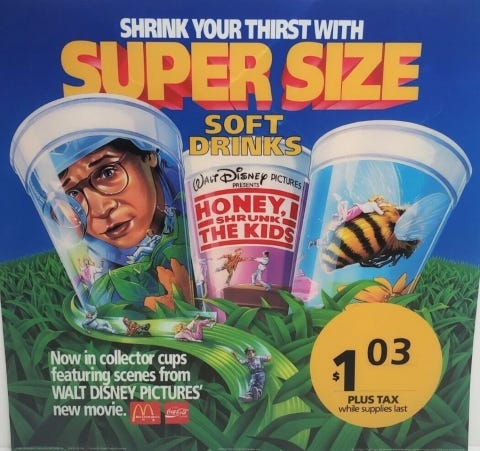By 1989, it was beginning to seem that live-action production might no longer have a place at Walt Disney Studios. Touchstone was thriving with movies geared toward a wide range of demographics. Disney Animation was slowly gathering steam, building up to a game-changing release later in the year. But live-action movies had essentially fallen off the radar. They’d partnered with other filmmakers to distribute movies like Benji The Hunted and Return To Snowy River but it had been years since they’d completely developed and produced an all-new live-action feature. The last thing anyone expected was for the director of Re-Animator to pitch a throwback to movies like The Absent-Minded Professor that would revitalize Disney’s dormant live-action side.
Stuart Gordon first came to prominence in the burgeoning Chicago theatre scene in the 1970s. His Organic Theater Company quickly developed a reputation for developing some of the most innovative and unique underground stage productions in the country. Eventually, his interests turned to film. His first two features, the H.P. Lovecraft adaptations Re-Animator and From Beyond, were instant cult classics. Even so, there was little in his background to suggest he’d even consider working for Disney.
But, as was the case with Billy Joel’s participation in Oliver & Company, parenthood made a big difference. One of Gordon’s daughters visited the set of the horror movie Dolls and asked if any of the dolls were good or if they were all evil. If you’ve seen Dolls or really any of Stuart Gordon’s movies, you can probably guess the answer. At this point, Gordon began to wonder what kind of father only makes movies about murderous evil dolls. Like a good dad, he lied and said the doll his daughter liked was a good one and he let her have it.
Around the same time, Gordon’s producing partner, Brian Yuzna, found himself in a similar position. Yuzna’s kids attended school with the children of Jeremy Kagan, director of The Journey Of Natty Gann. When that movie came out, Kagan arranged a special screening for the entire school. Yuzna’s kids came home demanding to know why their dad never screened his movies for them and their classmates.
Together with Yuzna and Ed Naha, the writer of Dolls, Gordon decided to flesh out a bedtime story he’d told his daughter. The script was called The Teeny Weenies and Gordon brought the project to Disney. Jeffrey Katzenberg liked it but didn’t love it. He had plenty of notes to incorporate before he’d give it a green light. Eventually, Tom Schulman, whose screenplay for Touchstone’s Dead Poets Society would go on to win an Oscar that year, was hired to punch up the script. But after a lengthy back-and-forth, Katzenberg finally approved the project with Stuart Gordon directing.
Unfortunately, the stress of the development process had taken a toll on Gordon. After he began experiencing spontaneous nosebleeds, his doctor informed him his blood pressure was through the roof. With his health on the line and just weeks away from starting production, Gordon made the difficult decision to step away from the movie he’d wanted to make for his kids. He developed a few more projects at Disney but none of them came to fruition. In 1998, he would return to the franchise to direct an episode of Honey, I Shrunk The Kids: The TV Show. But for now, he would have to let someone else steer the ship he’d help build.
Stepping in at the eleventh hour was Joe Johnston, an Oscar-winning visual effects artist and art director who had worked on the Star Wars and Indiana Jones films. Johnston had never directed before but his effects background was incredibly useful. In a later interview, Stuart Gordon would say that Johnston essentially followed the road map he’d already laid out for him. Which is not to take anything away from Joe Johnston. He definitely proves himself as a director here and we’ll see more of his work later.
Casting the film also proved to be somewhat challenging. Gordon had written the part of Wayne Szalinski, the suburban inventor, with Chevy Chase in mind. But Chase was already committed to shooting National Lampoon’s Christmas Vacation and had to pass. The role was then offered to John Candy, who’d signed a development deal with Disney after Splash. Candy also declined but not before recommending his SCTV costar Rick Moranis.
Despite scene-stealing turns in films like Ghostbusters and Spaceballs, Rick Moranis was not exactly a box-office draw. The few films he’d anchored, including Strange Brew and Little Shop Of Horrors, had built their audiences after disappointing theatrical runs. But Moranis was exactly the right choice to play Wayne Szalinski. It’s one of those casting decisions that make you wonder how anyone else could have been seriously considered.
Honey, I Shrunk The Kids wisely takes its time before shrinking the kids, giving us a chance to get to know Wayne, his kids Amy (Amy O’Neill) and Nick (Robert Oliveri), and the family next door, Big Russ Thompson (Matt Frewer in one of his first big post-Max Headroom roles), his wife Mae (Kristine Sutherland, the future mother of Buffy The Vampire Slayer) and their sons Little Russ (Thomas Wilson Brown) and Ron (Jared Rushton, who’d recently played Tom Hanks’ best friend in Big). Neither household presents an image of perfect domestic harmony. There are hints that Wayne’s marriage to Diane (Marcia Strassman, probably best known for Welcome Back, Kotter) is on the rocks. Next door, Big Russ is trying too hard to mold his namesake son in his own hyper-masculine image, despite clear signs that Little Russ has no interest in fishing and football.
Things get going when Ron’s baseball crashes through the Szalinskis’ attic window, lodging itself in Wayne’s malfunctioning shrink ray prototype. Thanks to the miracle of movie science, the ball turns out to be the missing piece that causes the ray to work perfectly. The four kids are shrunk smaller than insects, leaving them unable to get Wayne’s attention when he returns home. He sweeps them up and tosses them out with the trash.
One of the smartest moves Honey, I Shrunk The Kids makes is keeping the story very tightly contained. The focus never veers away from the Szalinski and Thompson residences. The stakes are almost laughably small: this really is a movie about four kids who have to make it across their backyard to their house. But at their size, the dangers are very real and the journey quickly takes on epic proportions.
The production design by Gregg Fonseca, art direction by Dorree Cooper and John Iacovelli and visual effects team, which included legendary stop-motion animator Phil Tippett, all work together to bring the overgrown yard to life. Cinematographer Hiro Narita, who had earlier shot Never Cry Wolf, uses a lot of forced perspective and other optical illusions to enhance the designers’ work. As a result, the movie looks quite a bit better than similar Disney sci-fi comedies of the ‘60s and ‘70s.
As for the kids themselves, they’re a likeable, resourceful group that feel grounded in reality despite the situation they find themselves in. The dynamic between the two sets of siblings isn’t identical, but both feel like believable familial relationships. The growing attraction between Amy and Russ is cute without being heavy-handed. Even Ron, who could have easily come across as an insufferable little irritant, never goes too far into caricature. The bond he develops with Antie, the ant he trains to help them along their way, is surprisingly sweet. It’s even more surprising considering that the ants, scorpions and other insects are designed very realistically without softening their somewhat monstrous appearance. This isn’t Flik from A Bug’s Life. This is literally your garden variety ant.
Honey, I Shrunk The Kids opened in theatres on June 23, 1989, the same day as Tim Burton’s heavily hyped Batman. On the surface, this sounds suicidal. But it turned out to be a savvy bit of counterprogramming, especially after critics and the media started warning parents that Burton’s superhero movie was much too dark for kids. Batman predictably won the weekend but Honey opened in a very respectable second place. The movie ended up surprising everyone, becoming the fifth highest-grossing movie of 1989, earning more than highly anticipated sequels like Ghostbusters II and Back To The Future Part II.
On its original release, Honey, I Shrunk The Kids also brought along a special guest: Roger Rabbit in the all-new animated short Tummy Trouble. This was supposed to be the first in a new series of Roger Rabbit cartoons created by Disney exclusively for theatres. Unfortunately, the experiment didn’t last long. Only three shorts were ever released, accompanying the theatrical releases of Dick Tracy and A Far Off Place. We’ll get to Roger Rabbit over on the Touchstone side eventually and we’ll take a closer look at the shorts then.
Honey, I Shrunk The Kids proved that Disney could still deliver the goods in fields other than animation. It was a throwback to a style the studio had largely abandoned but, in many ways, it improved on the gimmick comedy formula with more engaging characters and improved visual effects. No one expected it to be as big a hit as it became. But once it did, a sequel became inevitable. The Szalinskis will return.
VERDICT: Disney Plus






